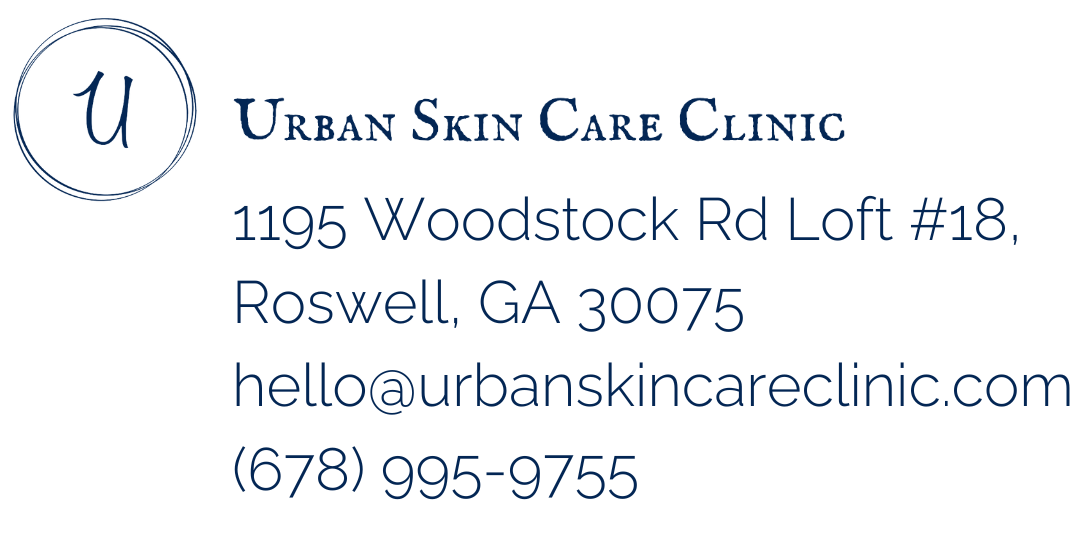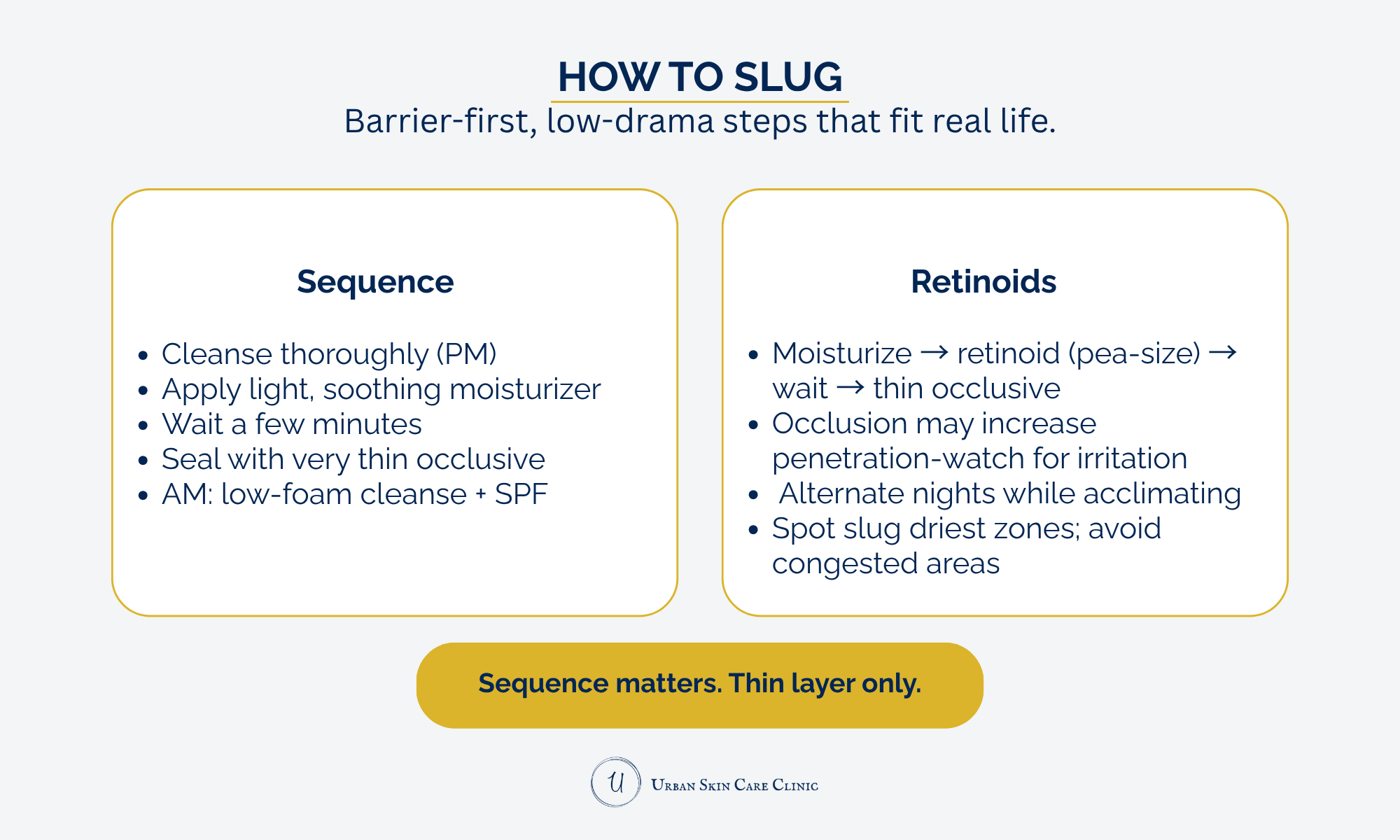Slugging for Barrier: The North Fulton Guide to Stronger, Calmer Skin
Skin needs rhythm more than it needs novelty. After a summer of sun and sweat, many complexions in Roswell and Greater Atlanta feel tight after cleansing, sting with active serums, and look shiny yet flaky by afternoon. That is classic barrier confusion. One low-tech, high-comfort technique that keeps trending for good reason is called “slugging.” Done correctly, it can be the difference between feeling perpetually sensitized and waking up comfortable, even during weather swings. Done poorly, it can trap congestion, flare breakouts, and leave you wondering what went wrong. This guide from Urban Skin Care Clinic explains exactly what slugging is, who it serves, how to adapt it for different skin types and tones, and how to incorporate it into a realistic routine you can actually keep.
What is slugging?
Slugging is the practice of sealing your evening routine with an occlusive layer to reduce transepidermal water loss while you sleep. The classic choice is petrolatum, a highly effective occlusive that is inert, fragrance-free, and excellent at locking in water. Think of it like putting a lid on your skincare so all the beneficial hydration you just applied does not evaporate into the air the moment your heater kicks on. The goal is increased comfort, less morning tightness, and a smoother look to dry patches without relying on ever-stronger actives. In a climate like North Georgia’s, where fall and winter bring indoor heat and lower humidity, slugging can feel like a weighted blanket for your face—calming, dependable, and simple.
Start with a clean, damp canvas
Before you try it, you need a clean canvas. Slugging is not a workaround for skipping your evening cleanse. It works best on thoroughly cleansed, slightly damp skin layered with a basic moisturizer first. The moisturizer provides humectants like glycerin and soothing ingredients like panthenol or ceramides, while the occlusive layer sits on top and keeps all that water in place. If you apply an occlusive directly onto bare, dry skin, you are not adding moisture; you are just sealing in dryness. That is when people say slugging “did nothing.” The sequence matters more than the product name.
Personalize frequency by skin type
Not everyone should slug every night, and frequency is where personalization shines. If your skin is dry, tight, or visibly flaking, a few nights per week can restore comfort quickly. If your skin is combination or oily with a history of clogged pores, once a week or reserved for windy days and post-treatment evenings may be plenty. Acne-prone clients often do best slugging only the driest zones rather than the entire face. A targeted approach—cheeks and around the mouth, for example, but not the T-zone—delivers the comfort without amplifying congestion. Start small, observe for a week or two, and then adjust.
Choosing products: occlusive vs. rich cream
Product choice is straightforward and depends on your preferences and sensitivity. Petrolatum ointments are the most occlusive option and the standard for classic slugging. If you prefer a lighter feel, rich creams that combine occlusives with ceramides and cholesterol can provide a similar seal in a more elegant texture. The decisive factor is tolerance: if your skin is calm and hydrated in the morning without new congestion, you’ve found your match. If you wake up with tiny closed bumps, pull back on frequency, reduce the amount you apply, or switch to a lighter sealing product and keep it off the oiliest zones.
Retinoids + slugging: how to layer
Layering matters when you’re using active ingredients. Many clients in Roswell love retinoids in the fall for their smoothing and brightening benefits. You can pair retinoids with slugging, but you need to be mindful of intensity. Occlusion can increase the penetration of active molecules and, in some people, magnify irritation. A practical approach is to apply your moisturizer, allow it to settle for a few minutes, apply a pea-sized amount of your retinoid evenly, wait another few minutes, and then seal with a very thin occlusive layer. If your skin is still acclimating to retinoids, alternate nights instead or reserve slugging for non-retinoid evenings until your barrier is happy. Remember, comfort is the metric, not how many products you can stack.
Technique & hygiene tips
Hygiene and application technique are the quiet details that make slugging work in real life. Apply your occlusive with clean hands to clean skin, use a very thin layer so your face feels cushioned rather than coated, and consider a satin pillowcase you can wash easily. If you are worried about transfer to your hairline, wrap your hair or use a soft headband. If you tend to sleep hot, a lighter product or spot-slugging just the driest patches may help you stay comfortable. Morning removal is gentle: cleanse with your usual low-foam cleanser and lukewarm water. You are not trying to “strip” the skin; you are just lifting the seal so daytime products and sunscreen can layer smoothly.
Acne-prone? Use a hybrid approach
If you are dealing with acne, you are not excluded from comfort. The same sealing principle that rescues dry cheeks can help protect the corners of the nose and the mouth where retinoids often cause flaking. The trick is to avoid blanketing actively congested areas and to keep your leave-on exfoliants on a separate night when possible. Pay attention to the smallest dose that keeps you comfortable, and be willing to back off the T-zone. Many acne-prone clients in our Roswell studio end up with a hybrid routine: strategic slugging on dry zones, a gel moisturizer elsewhere.
The big picture
Slugging will not replace sunscreen, antioxidants, or a smart retinoid plan, but it can be the quiet hero that makes those steps tolerable and sustainable. In the colder months ahead, as indoor heat pulls moisture from the air, that thin occlusive seal can preserve the hydration your serums work so hard to supply. Over time, the payoff is skin that looks calmer by mid-day, makeup that sits more smoothly, and far fewer nights spent navigating surprise sensitivity.
Get a personalized plan
If you want help personalizing slugging for your skin type and tone, schedule a schedule a consultation at Urban Skin Care Clinic in Roswell. We will map your routine, show you how to layer products so each step does its job, and design a realistic plan that fits your life in Alpharetta, Sandy Springs, and East Cobb as easily as it does in Roswell.




